The MacBook Pro Review (13 & 15-inch): 2011 Brings Sandy Bridge
by Anand Lal Shimpi, Brian Klug & Vivek Gowri on March 10, 2011 4:17 PM EST- Posted in
- Laptops
- Mac
- Apple
- Intel
- MacBook Pro
- Sandy Bridge
6Gbps SATA
Twenty eight days after Intel launched its Sandy Bridge microprocessors, it announced the stop-shipment of all 6-series Sandy Bridge chipsets. The first shipping version of these chipsets (B2 stepping) was affected by an unfortunate "oversight" that could cause failure in the four 3Gbps SATA ports that branch off the chipset. The remaining two 6Gbps SATA ports were unaffected by the bug.
Most notebooks only use two of the six SATA ports supported by most members of Intel's 6-series chipset family. If a notebook design used the 6Gbps ports exclusively, the notebook would be fine to ship using the flawed B2 stepping parts. With the 3Gbps ports not in use the bug would never show up. Notebooks that used more than just two ports or used at least one of the 3Gbps ports would be affected and would have to be remanufactured with a fixed version of the 6-series chipset. Intel promised to begin shipping fixed (B3 stepping) 6-series chipsets by the end of February.
Apple announced and started selling the 2011 MacBook Pro lineup on February 24, four days before the end of the month. Surely that would be too soon for Apple's manufacturing partners to have received B3 stepping chipsets, built boards around them, integrated them into MacBook Pro designs and shipped them half way across the world to Apple stores all around the US.
Naturally Apple wouldn't comment on what chipset revision was in the 2011 MacBook Pro, so the first thing we did was check to see what SATA ports were in use on our systems.
Here we have the high end 15-inch MacBook Pro. I installed an Intel SSD 510 in the lone 2.5" drive bay and it is connected via a 6Gbps port internally:
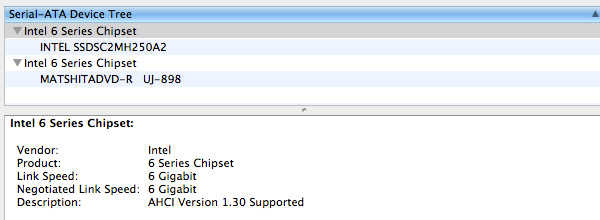
So far, so good. The only other bay in the new MacBook Pro is used for the optical drive. And it's connected to a:
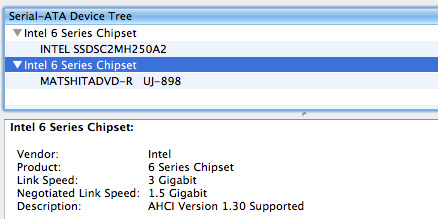
...3Gbps SATA port. Uh-oh.
Apple doesn't directly report chipset IDs under OS X. I installed Windows 7 via Boot Camp and headed over to device manager to pull the device ID of the SATA controller: 1C01.
Cross referencing with Intel's datasheets I found that there are two revisions of the SATA controller: 04 and 05. The latter is used in the "fixed" B3 stepping chipsets. And what do we have here at the end of the hardware ID string for the SATA controller?
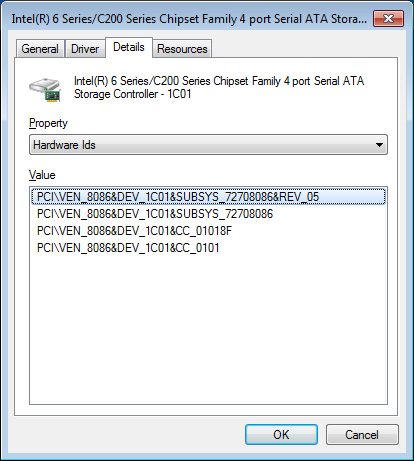
REV_05.
This is a B3 stepping chipset. In fact, Apple's manufacturing partners seem to have received B3 chipsets before anyone else given that boards were produced, tested and shipped in time for a February 24th launch. It would appear that Apple was among the first if not the first company to receive B3 stepping 6-series chipsets. Although I had concern for the health of the Apple/Intel relationship over the past couple of years, it looks like the two are back to being bedfellows.
Internally there are no visible changes to the MacBook Pro's primary SATA cable. It's still a flex cable but apparently capable of delivering twice the bandwidth of last year's model. Apple doesn't ship the new MacBook Pros with any 6Gbps drives and I would be surprised if it selected anything other than Samsung or Toshiba for SSDs, which means even the SSD options are 3Gbps. Luckily I happen to have a small cache of SSDs, including a bunch of new 6Gbps offerings.


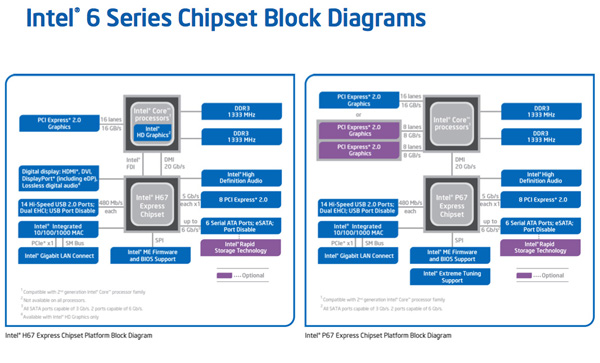
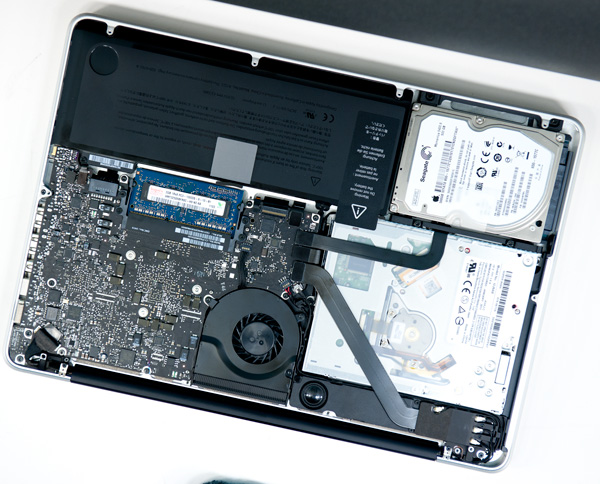








198 Comments
View All Comments
Anand Lal Shimpi - Friday, March 11, 2011 - link
Thank you for reading them, comments like this really do make it all worthwhile :)You wouldn't believe how much time was spent making sure Apple wasn't doing something funny with the max turbo frequencies. At the end of the day it was a non-issue, but we had to be sure.
Take care,
Anand
Ryan Smith - Friday, March 11, 2011 - link
Just to add some technical background to this, it's actually quite complex to get a CPU speed reading on modern CPUs. Mac OS X's Sysctl reports the base speed of the processor, regardless whether Turbo Mode is active or not. So on the 15" low-end QC model you will always see 2.3GHz.To actually read the instantaneous speed of any given core, you need to peek at the CPU itself and count the cycles - Intel actually has a handy document detailing an algorithm to do this(1). The issue with that is that it requires peeking at the Model-Specific Registers (MSRs), which require Ring 0 access; or in other words you need a broker at the driver level to do it.
Linux already does this (/proc/cpu/0/msr), and on Windows it's fairly trivial to load a driver alongside an Admin-level application to do this(CPU-Z, etc). Under Mac OS X this requires installing an Extension (at least as far as I know) which gets messy. If you don't go through this process you'll never be able to read the core speeds accurately, which is why there's virtually no Mac software capable of this.
Fortunately MSR Tools exists, and it has a 32bit extension to allow it to peek at the MSRs. The right answer of course is always the last answer you try, so this was only after trying several other ways of calculating the CPU speed and a couple different OS-agnostic benchmarks to try to rule out OS differences.
1) http://download.intel.com/design/processor/applnot...
tno - Friday, March 11, 2011 - link
+1I've been planning to plunge into Mac ownership for sometime, especially with grad school looming I really want something that's more comfortable to work on than my netbook but still fairly portable. This review really helped me gauge whether it was worth putting in the extra cost for a 2011 13" MBP or settle for a discounted 2010.
So am I all set? Hardly! Now I need to see what the 2011 13" MBA has to offer! I'm praying that cost stays roughly the same and a move to a ULV SNB leads to 12+ hour battery life and a similarly huge leap in performance as the move lead to in the MBP. I am a sucker for lightweight form factors.
This article is also the first one to make me ever consider the 15" MBP. I have been fairly opposed to the bulk but the performance is quite something. If I went that route then I would probably have a C2Q, water-cooled, ATI and SSD driven rig to put up on AT forums. Taking offers!
tno - Wednesday, May 4, 2011 - link
Rezzing a dead thread! I bought the 13" MBP! $999 at MicroCenter, too good to pass up! So . . . who wants my rig?JasperJanssen - Saturday, August 6, 2011 - link
I, on the other hand, have gone the other way. My MBA13 is being put together in China now.ltcommanderdata - Thursday, March 10, 2011 - link
A great review. I do have some additional questions though. First, given Apple was the instigator of OpenCL, it'd be great if you could run some OpenCL benchmarks. Are the Sandy Bridge MacBook Pro's disproportionately faster than the Arrandale MacBook Pro to indicate that OS X has CPU OpenCL drivers that can take advantage of AVX? Probably not, and this will hopefully come with Lion. Given nVidia's GPGPU push can the HD 6490 still keep up with the 330M GT in OpenCL? How does the HD6750 do?http://www.bit-tech.net/hardware/graphics/2011/01/...
"'[Intel] will be releasing OpenCL graphics drivers to developers during the course of 2011. [Intel] continue to evaluate when and where OpenCL will intercept various products"
And is there secret Sandy Bridge IGP OpenCL support? Bit-tech got a quote from Intel that Sandy Bridge IGP OpenCL support was inbound sometime this year and if anyone would be motivated to get it done it'd be Apple.
And finally, does Apple now support hardware H.264 decoding on ATI or Intel GPUs? Previously, only a few nVidia GPUs were supported in Snow Leopard, such that the Arrandale MacBook Pro actually had to power up the 330M GT to decode H.264 wasting power compared to the perfectly fine Arrandale IGP if Apple just wrote the drivers. Do the new Sandy Bridge have the ATI GPUs doing H.264 decoding now, is the Intel IGP supported, or in the worst case is no H.264 hardware acceleration available now that nVidia GPUs are gone? Perhaps lack of hardware H.264 decoding is what makes the FaceTime HD CPU usage so high? QuickSync is only accelerating the encoding phase?
Anand Lal Shimpi - Friday, March 11, 2011 - link
Some answers:1a) I don't know of any good GPU based OpenCL tests under OS X at this point. I'm not even sure if Apple's Intel HD 3000 driver supports OpenCL.
1b) Intel mentioned SNB's GPU technically supports OpenCL however there are no plans to release a public driver at this point.
2) Hardware H.264 decoding is enabled on the 2011s and it is used while FaceTiming, at least according to Apple.
Take care,
Anand
ltcommanderdata - Friday, March 11, 2011 - link
Thanks for the reply.http://www.macupdate.com/app/mac/33632/smallluxgpu
In regards to OpenCL testing, most people in OS X seem to use SmallLuxGPU which is an OpenCL raytracing benchmark. I don't have much experience with it, but it might be worth a try.
In regards to hardware H.264 decode, do you know if the IGP is doing it or does the discrete GPU still have to be powered up as in the 2010 Arrandale MacBook Pros?
Thanks
Anand Lal Shimpi - Friday, March 11, 2011 - link
It's my understanding that the IGP can do the decoding, although note that while FaceTime is running the dGPU is enabled by default.Good call on SLG, I had forgotten about that :)
Take care,
Anand
secretmanofagent - Thursday, March 10, 2011 - link
Hello authors,On one of the pages, you mentioned this:
"This isn't Mac specific advice, but if you've got a modern Mac notebook I'd highly recommend upgrading to an SSD before you even consider the new MacBook Pro. I've said this countless times in the past but an SSD is the single best upgrade you can do to your computer."
Is there an article where you recommend the best update for my model? Should I even bother with the drive? I realize the X3100 is going to still hamper any sort of graphical performance, but wondering if it's worth the effort.
Out of curiosity as well, would a Time Machine restore be possible if you update the drive?